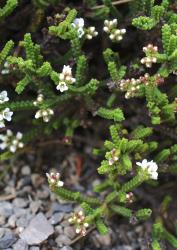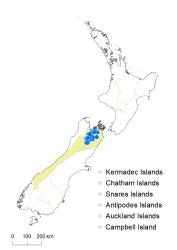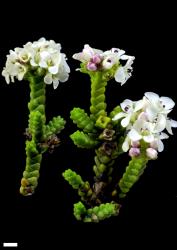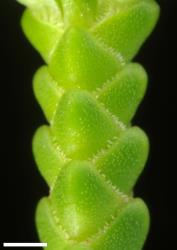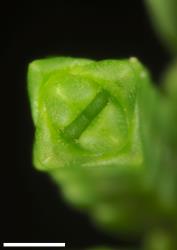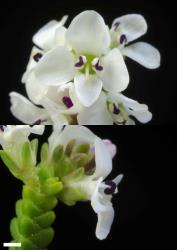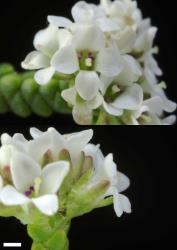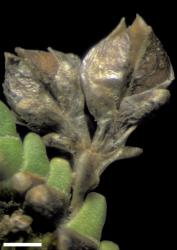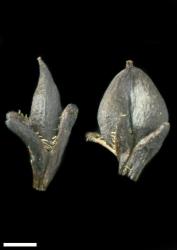- ≡ Hebe tumida (Kirk) Cockayne & Allan, Trans. New Zealand Inst. 57: 39 (1926)
- ≡ Leonohebe tumida (Kirk) Heads, Bot. Soc. Otago Newsl. 5: 5 (1987)
Semi-whipcord sub-shrub to 0.2 m tall. Stems decumbent to ascending, glabrous. Leaf bud indistinct, its outer leaves fully grown, diverging. Leaves opposite-decussate, connate in pairs and encircling stem, erecto-patent, crowded and overlapping, separating early; lamina sub-coriaceous, deltoid, 1–1.5 mm long, 1.5–2.5 mm wide, dull green to dark green above and beneath; veins not evident; surfaces glabrous; margin ciliolate in lower half, glabrous towards apex, entire; apex rounded, and back of the leaf keeled with a rounded swelling; bases broad; petiole absent. Inflorescence a lateral spike or raceme, 2–9 mm long; flowers crowded, 2–8, female or male on separate plants, ♂ ≈ ♀; bracts opposite-decussate, free or barely connate, deltoid or oblong, > pedicels; pedicels absent or erecto-patent to spreading, 0–1 mm long, glabrous or eglandular-hairy all around. Calyx lobes 4, obtuse, equal, 1.5–2.0 mm long, mixed eglandular- and glandular-ciliolate. Corolla 3.5–4 mm diameter; tube white, 1–2 mm long, ≤ calyx, glabrous; lobes 4, white, erecto-patent to spreading, sub-equal, broadly elliptic to ovate or sub-orbicular, 1.5–2.0 mm long, obtuse to rounded; nectar guides absent. Stamen filaments white, 1.0–1.2 mm long; anthers purple, paler or pink in ♀. Style glabrous, 1–4 mm long. Capsules angustiseptate, obtuse to emarginate, glabrous, 1.5–3.2 mm long, 1.3–2.7 mm at widest point. Seeds discoid to ellipsoid, flattened, smooth, pale brown, 0.8–1.1 mm long.
V. tumida belongs to a well-supported clade of four species, the semi-whipcord hebes; the other species are V. hookeri, V. quadrifaria, and V. tetrasticha. Relationships within this grouping are unclear.
Semi-whipcord hebes are characterised, and distinguished from true whipcord hebes, by very crowded, dull green, scale-like leaves that are long-persistent on old stems, dioecious sexual systems, and angustiseptate capsules.
In habit, V. tumida plants resemble V. tetrasticha and V. quadrifaria plants; V. hookeri plants have longer leaves. The swollen, rounded keels on the backs of the leaves are distinctive and distinguish V. tumida plants from the other semi-whipcord hebes.
South Island: Sounds Nelson (Bryant Range, Richmond Range, Gordon Range), Westland (mountains near Lake Rotoiti), Marlborough (Raglan Range).
Alpine rock outcrops and scree. Recorded elevations range from 1280 to 1800 m.
At Mt Robert some specimens appear intermediate between V. tumida and V. hookeri, whereas at the eastern extremes of its range some specimens are intermediate between V. tumida and V. quadrifaria.
Flowers: November–February; fruits: January–April.
2n = 42 (see Bayly & Kellow (2006), as Leonohebe tumida).
Veronica tumida is classified in V. subg. Pseudoveronica sect. Hebe and informally in the “semi-whipcord hebe” group (Albach & Meudt 2010).
Some populations of V. tumida might be gynodioecious rather than strictly dioecious, because some polliniferous plants appear to also have fruit.



